Expert Advice on Moving Out Mosquitoes
[flashvideo file=http://www.youtube.com/watch?v=BPNvT7_7e9g /]
The new year brings new cases of Dengue fever. The Department of Health’s update on February 1 reports a total of 244 confirmed cases in Hawaiʻi since September 2015. Health officials have also confirmed a case of Dengue fever in a Maui resident. See our exclusive story here.
The biggest concern remains on the Big Island of Hawaiʻi, where the health officials are investigating the first cluster of locally-acquired Dengue fever since the 2011 outbreak on O’ahu. Of the confirmed cases, 220 are Hawaiʻi Island residents and 24 are visitors. 199 cases have been adults; 45 have been children under age 18.
The latest Dengue outbreak, which started Sept. 11, is now the largest since statehood. Hawaiʻi’s second-largest outbreak was in 2001, when 122 confirmed cases were reported.
Two types of mosquitoes transmit the virus, and all mosquitoes lay their eggs in water. Maui excavation and landscaping expert Shayne Edelhertz has met many a mosquito, and says the bugs look for any standing water they can find.
“They’re borne in water. It’s an ingestion period of water for maybe two days, and then they hatch out of the water and become airborne,” explains Edelhertz, who owns Country Excavation. “So to get them before that happens, you can come across a five-gallon bucket with 1,000 mosquito larvae getting ready to jump out of there.”
Whether the issue is illness prevention or just inconvenience, reducing the number of bugs on your property is important, and that means maintenance. Edelhertz says vacant sites should be cleared every three to six months.
“Within a three-to-six-month growth, you can create a habitat for a few million insects, as well as breeding ground for mosquitoes,” he says. “We’ll cut a path through an unmowed area and it’ll be like a stampede of insects and rodents, which are quickly eaten up by the egret birds.”
In wetter areas, the slope of your property also makes a difference as to where and how well the water drains.
“If your property wasn’t graded initially, it can saturate in low-lying areas and create puddles of water that you may not see,” Edelhertz explains. “So you can fill in those lower areas to try to make the water drainage; ideally, it’s good to have a property that’s well-contoured to account for the water that comes to it, to shed it to either a stream that has moving water or any area that will dissipate it quickly.”
While mosquitoes will opt for standing water pretty much anywhere, some plants make it easier for them. For instance, Edelhertz says invasive cane grass can hold moisture and harbor bugs, while Elephant Ear plants will grow very large and catch water easily.
“When you have rain nonstop every day, they’re gonna fill up with water and create breeding grounds,” he says, “so unless you have a specific purposes for these types of plants around, you’ll want to limit them to out-of-the-way areas, or maintain them.”
Other plants, along with essential oils like peppermint and clove, can naturally repel mosquitoes.
“Citronella is one that grows well in a potted area closer to your house,” he explains. “The eucaplyptus trees, when maintained, can also create an oil and a smell that deters mosquitoes and other bugs.”
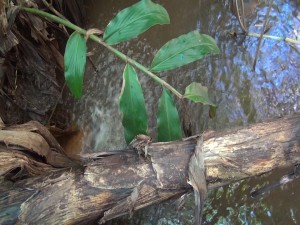
Creeks and streams provide sources for drainage and moving water, which can repel mosquitoes. Photo by Kiaora Bohlool.
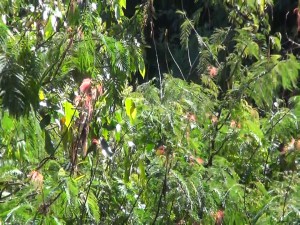
Experts say clear vacant property every three to six months to avoid a buildup of bugs. Photo by Kiaora Bohlool.

Shayne Edelhertz with Country Excavation on Maui. Photo by Kiaora Bohlool.

Elephant Ear plants can catch water and breed mosquitoes. Photo by Kiaora Bohlool.

Invasive cane grass can trap moisture and provide harbor for mosquitoes and other insects. Photo by Kiaora Bohlool.
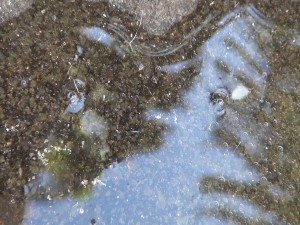
Mosquitoes lay eggs in standing water. Photo by Kiaora Bohlool.
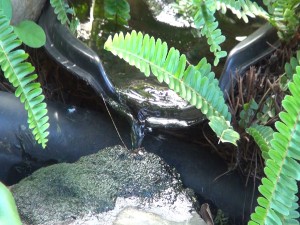
Keep water in ornamental ponds moving, and consider adding mosquito-eating fish or frogs to deter bugs. Photo by Kiaora Bohlool.
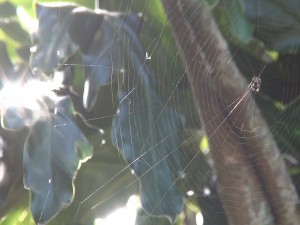
A spider gets rid of mosquitoes the old-fashioned way. Photo by Kiaora Bohlool.

Country Excavation crews at work on the land. Courtesy photo.

Freshly-mowed parcel of land. Photo courtesy of Country Excavation.

Kubota lawnmower with Country Excavation. Courtesy photo.

Country Excavation at work in an excavator. Courtesy photo.
Eucalyptus wood chips are more beneficial that other wood chips, but Edelhertz says don’t forget they will decompose. That could attract centipedes and other insects, so keep the chips away from your house, sprinkle them around trees or a garden, and replace them every three months or so.
Don’t count out drier climates, either, says Edelhertz. Since it doesn’t take much water to breed mosquitoes, make sure trash cans and even little cans of water are covered.
“It’s such a welcoming environment, all you have to do is add a bucket of water or a little shade to a well-sunned area and you’ll have a mosquito environment,” he explains, adding that ornamental ponds need to stay in motion. “People that have small ponds, you want to introduce either mosquito-eating fish or frogs that eat mosquitoes; have that pond be moving with a small solar pump or 12-volt pump that can recirculate the water.”
Edelhertz says keeping invasive plants and bugs under control should be a priority for all of us.
“It’s your responsibility, it’s your kuleana to watch out for the land, and maintain it so that the people around you as well as yourself are in a clean, safe environment,” says Edelhertz.
At the state level, the Department of Health continues to routinely monitor for cases of imported Dengue infection on all islands, and will have Vector Control perform mosquito site assessments and abatement as needed. On the Big Island of Hawaiʻi, the state has started holding weekly public information sessions in Kona and Hilo, to provide updates and answer questions about the outbreak. Learn more on how the state is taking action here.
A different mosquito-borne infection also made headlines last Friday. A baby was born in an O’ahu hospital with a neurological condition called microcephaly, and tested positive for the Zika virus, which health officials say can have serious health impacts. But they add there is no risk of transmission in Hawaii. Learn more details from the Department of Health here, including where the virus may have come from.












